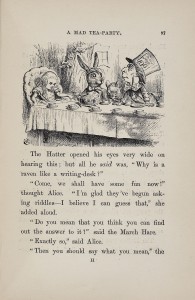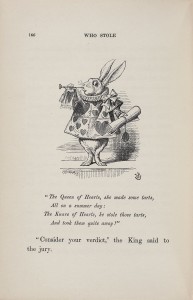
As it says on the Statue of Liberty: “Give me your tired…your huddled masses yearning to breathe free…” and the newly-found abandoned line “…your unwanted editions, pages uncut, spines unopened, loathed by your authors and deemed unworthy cultural capital by your countrymen…”
Okay, maybe that isn’t exactly what it says. Perhaps the line’s lack of poetic cadence destined it for the chopping block. But the fact remains that Lady Liberty had her arms open for books too. One such prized text is in the collection of the American Antiquarian Society.
In particular, I’m talking about Lewis Carroll’s beloved Alice’s Adventures in Wonderland (1865).
Anachronistic, I know, as the Statue was given decades after Alice’s debut. But the point is this – British items, European prints, suppressed pamphlets – texts cast off and unwanted – have made their way into the American Antiquarian Society. And are here for the staying – and studying.
Lovers of Alice in Wonderland know the stormy, and at times formidable, relationship between illustrator John Tenniel (1820-1914) and author Lewis Carroll/Charles Lutwidge Dodgson (1832-1898) resulted in a book which – though conceived in 1862 – did not officially hit shelves until 1865. And immediately upon hitting said shelves was taken off for its printing imperfections. Tenniel, not Carroll, is responsible for the suppression of this first edition as he was very unhappy with the light printing of the pictures. Carroll, who had paid for the printing and was now in the red, decided to scrap it and please his illustrator. The official “accepted” edition was not published until late 1865 and bears an 1866 issue date. This leaves the 1865 edition as one of the most celebrated rarities of the book world.

So what happened to this ill-fated edition?
Enter New York harbor.
William D. Appleton of D. Appleton and Company of New York bought up the discarded copies of Alice, gave them a new title page and issued them as the first American edition in 1866. While debate still rages over which issue of the Appleton came first (there are two title pages), this copy is one of those rejected pieces – with light illustrations and all.
Why such a big deal? A couple copies where the blocks weren’t printed correctly? Who cares? Perhaps. But take a peek at Martin Gardner’s Annotated Alice to get an idea of much back and forth went into the illustrations between Carroll and Tenniel – how exacting and meticulous each artist was in his craft.
A light printing of something as subtle as a caricature or satirical illustration could make the difference between seeing and not seeing for viewers and readers. As Gardner highlights (and compiles), the text is exceedingly loaded and rich in its likenesses, parodies, and intricacies – and if you’re going to be the seminal subversive children’s literature text, you might as well get it right.

Other Carroll finds at the Society? Three other editions of Alice in Wonderland, several Through the Looking Glass-es, a version of the ‘Alice in Wonderland’ stage play, and The Hunting of the Snark. Oh, and what good nineteenth-century popular foreign text would be complete without its American-pirated counterpart? The serial Merryman’s Monthly is also in the Society’s holdings which printed the first pirated Alice in 1867 (interestingly, without its last five paragraphs).
Though this copy was not approved of by Tenniel, aren’t we glad he was such a perfectionist? After all, Alice has had numerous illustrators in her 145 years, both in print and on screen, and yet Tenniel’s version remains the most accepted visual for the text which is noteworthy for inspiring a ‘liberty of thought’ in children’s books.
Ever wonder what Lady Liberty is holding? Perhaps it’s a rejected copy of Alice.
Interested in Learning More?
See Flodden W. Heron, “The 1866 Appleton Alice,” Colophon 3:1 (Winter 1936), pp. 422-427 and Selwyn Goodacre, “The Nineteenth-Century American Alice” in Proceedings of the Second International Lewis Carroll Conference (NY: Lewis Carroll Society of North America, 1994), pp.68-74.

I enjoyed reading your PastIsPresent post on the Appleton Alice and would like to add just a little more information for your readers. In his 1956 Harvard Library Bulletin article (Vol. X, no. 3) “The Publication of Alice’s Adventures in Wonderland,” William H. Bond persuasively argued that the “Oxford University Press set up the cancel title page [i.e., the title page inserted into the approximately 1950 copies of the rejected 1865 Alice] in duplicate, just as it had earlier set up the two-leaf preliminary gathering.” Bond acknowledged that this explanation was first proposed by Flora Livingston in her privately published 1932 catalog The Harcourt Amory Collection of Lewis Carroll in the Harvard College Library. It is clear from our copy and other copies of the Appleton Alice with separated spines that the book was bound in England because strips of London Times newspaper back the spine of the book. A further bibliographic anomaly in the copies of the Appleton Alice was noted by Selwyn H. Goodacre in his essay “Lewis Carroll comes to America,” printed in Jon A. Lindseth’s catalog Yours Sincerely, C.L. Dodgson (alias Lewis Carroll) accompanying Lindseth’s brilliant 1998 Grolier Club exhibition. It is the case that there are actually four variants of the Appleton Alice. Here is Dr. Goodacre’s summary:
“He [William Worthen Appleton] negotiated the deal with George Lillie Craik of Macmillan’s. A new title page was needed. Carroll was charged for ‘1000 titles to Alice, American edition.’ These cancel title pages were printed in duplicate and the two differ slightly. In one, the B in By is directly above the T in Tenniel, and the other, it is above and just to the right of the T. … .With two variants of the 1865 sheets, (in the second preliminary [b2], and two variants of the cancel title page, there are four possible variants of the Appleton Alice.”
August A. Imholtz, Jr.
Thank you so much August! This is wonderful and helpful information!